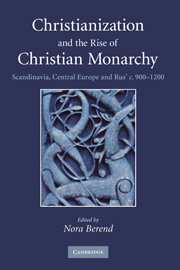Book contents
- Frontmatter
- Contents
- Contributors
- List of maps
- Acknowledgements
- Note
- List of common abbreviations
- Chapter 1 Introduction
- Chapter 2 From paganism to Christianity in medieval Europe
- Chapter 3 The kingdom of Denmark
- Chapter 4 The kingdom of Norway
- Chapter 5 The kingdom of Sweden
- Chapter 6 Bohemia and Moravia
- Chapter 7 The Kingdom of Poland, with an Appendix on Polabia and Pomerania between paganism and Christianity
- Chapter 8 The kingdom of Hungary
- Chapter 9 Rus'
- Index
- References
Chapter 2 - From paganism to Christianity in medieval Europe
Published online by Cambridge University Press: 24 June 2009
- Frontmatter
- Contents
- Contributors
- List of maps
- Acknowledgements
- Note
- List of common abbreviations
- Chapter 1 Introduction
- Chapter 2 From paganism to Christianity in medieval Europe
- Chapter 3 The kingdom of Denmark
- Chapter 4 The kingdom of Norway
- Chapter 5 The kingdom of Sweden
- Chapter 6 Bohemia and Moravia
- Chapter 7 The Kingdom of Poland, with an Appendix on Polabia and Pomerania between paganism and Christianity
- Chapter 8 The kingdom of Hungary
- Chapter 9 Rus'
- Index
- References
Summary
Between the tenth and the twelfth centuries new Christian monarchies were established throughout northern and central Europe. By the year 1200 Scandinavia was divided between the kingdoms of Denmark, Norway and Sweden, still today features of the political map of Europe, while in central Europe the Magyars, the pagan nomadic raiders of the tenth century, now ruled a large Christian monarchy, which was bordered on the north by the new Christian states of Bohemia, Poland and Rus'. In contrast to the expansion of Christianity into the eastern Baltic region in the thirteenth century (and also into Saxony in the ninth), the new religion was not imposed by invaders from outside but adopted by native elites.
When we use the term ‘Christianization’ as a label for this process, we seek to designate a transformation and hence imply a ‘before’ and an ‘after’. In the context of northern and central Europe, the ‘before’ is the world of indigenous European paganism, the ‘after’ is medieval Christian Europe. We know a lot more about the ‘after’ than the ‘before’. The Christian kingdoms and principalities of Scandinavia or central Europe, with their monarchical dynasties, ecclesiastical hierarchies and Latin learning, are known and recognizable parts of a Latin Christian world. There is plenty of room for more research into that world, but there is also a fair amount of evidence on which to base the research. When we turn to the ‘before’, the situation is quite different.
- Type
- Chapter
- Information
- Christianization and the Rise of Christian MonarchyScandinavia, Central Europe and Rus' c.900–1200, pp. 47 - 72Publisher: Cambridge University PressPrint publication year: 2007
References
- 16
- Cited by



